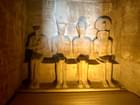Things to Do in Egypt
The Pyramids of Giza stand tall on the Giza Plateau near Cairo. They are a testament to ancient Egyptian engineering and craftsmanship. These monumental structures include the Great Pyramid, which is one of the Seven Wonders of the Ancient World. The Pyramids of Giza were built as tombs for Pharaohs. This historical marvel invites you to step back in time and explore the mysteries that have fascinated humanity for ages.
The Egyptian Museum in Cairo (EMC) is the oldest archaeological museum in the Middle East. It is famous for its mind-boggling collection of more than 170,000 artefacts collected from the Predynastic Period to the Greco-Roman Era. The museum has the highest number of treasured pieces of ancient Egyptian history including Tutankhamun's treasures.
Standing tall at 187 metres on Gezira Island, Cairo Tower is one of the most popular attractions in the city. It flaunts a lotus-inspired lattice, symbolizing Egypt's rebirth. From its observation deck, you can soak in panoramic views of Cairo's landscapes, including the Pyramids. The Cairo Tower is an architectural marvel, offering a glimpse into Egypt's history.
Immerse yourself in the rich history and architectural magnificence of the Al Azhar mosque in Cairo. The Al Azhar mosque is one of the oldest mosques in the world and was built in the 10th century. You can marvel at the towering minarets, sprawling courtyards, and sacred prayer halls. The Al Azhar University within the mosque is one of the best institutions in the world to obtain Islamic scholarship.
Discover the magic of Al Azhar Mosque and explore other attractions of Egypt with our curated Egypt tour packages and let its ancient charm and peaceful atmosphere make your trip truly memorable.
Explore the magnificent historic sites of Old Cairo and time travel several centuries back. Also referred to as Historic Cairo, Old Cairo is a UNESCO-listed World Heritage Site. Located by the Nile River, this historic district is home to several ancient monuments like mosques, churches, and markets. Old Cairo portrays the rich culture and heritage of Egypt and immerses you in the various eras of Egyptian history.
Discover the charm of Old Cairo with special Cairo packages. Explore its ancient streets, mosques, and markets for a journey back in time you'll always remember.
Get a chance to experience the market vibes of Khan el-Khalili, a bustling bazaar in Old Cairo. This souk built in the 14th century radiates ancient charm. You can walk through the alleys, and shop for souvenirs like Arabian lamps and artistic metalware. In between your shopping episodes, you can also treat yourself to delicious Egyptian street food like falafel, shawarma, and kofta.
Coptic Cairo, located in the heart of Old Cairo, is a remarkable enclave of ancient churches, a synagogue, and the impressive Coptic Museum. Wander through lanes that echo with history, and witness the ruins of the Roman fortress of Babylon. Visit the Hanging Church and the St. Sergius and Bacchus Church to learn about Coptic Christianity. This tranquil district offers a unique glimpse into Egypt's Christian heritage. It invites you to explore its serene beauty and historical depth.
The Citadel of Cairo is a testament to Egypt's medieval defence architecture. It was built by Salah al-Din in the 12th century. This military complex offers panoramic views of Cairo from its vantage point on Mokattam Hill. Inside, you will find museums and ancient mosques like the Muhammad Ali Mosque, which are historically quite significant. A visit to the Citadel is a journey through time, showing Cairo's evolution from the historic to the modern-day era.
The Sultan Hassan Mosque is an excellent example of the architectural brilliance of the Mamluk rule in Egypt. It is located near the Citadel in Cairo and can be easily spotted by its towering minarets and vast courtyard. Built in the mid-14th century, this mosque and madrassa complex is known for its grandeur and intricate details. Its walls whisper stories of history, culture, and religion, making it a top spot to appreciate the rich heritage of Cairo.
Al-Azhar Park, a lush retreat amidst Cairo's deserts, is a transformed space from a landfill to a verdant garden. Donated by Aga Khan IV, this 30-hectare sanctuary blends serene landscapes with panoramic views of this Egyptian city. It is a peaceful escape in this place, with flower paths, cultural landmarks and top-notch restaurants. An example of urban renewal, the park is a popular spot for relaxation and cultural activities to immerse in.
Zamalek
Nestled on the Gezira Island along the River Nile, the Zamalek district offers a blend of leafy avenues, posh dining, and a lively arts scene. Renowned for its European-inspired architecture, this district is home to cultural landmarks like the Nilometer and Cairo Opera House. From dining aboard floating restaurants to browsing chic boutiques, Zamalek represents Cairo’s cosmopolitan charm.
Nestled in the heart of Cairo, Ibn Tulun Mosque stands as one of the best examples of Islamic architecture's grandeur. Built in the 9th century by Ahmed Ibn Tulun, it is Cairo's oldest and largest mosque and retains its original form. It is famous for its courtyard, spiral minaret and captivating geometric stucco decorations. This architectural masterpiece is also a great place to learn about the rich history of Islam.
The Al Manial Palace Museum in Cairo is a treasure trove of Islamic art, nestled in lush gardens. Built by Prince Muhammad Ali in the early 20th century, it showcases a fusion of Ottoman and Mamluk styles. Here, you can marvel at rare manuscripts, exquisite carpets, and artefacts tucked within the historic walls. A visit to this attraction promises a glimpse into royal luxuries and architectural brilliance.
The Nilometer on Cairo's Roda Island is a marvel from AD 861, tucked inside Manasterly Palace. It was a vital agricultural tool for predicting the floods in the Nile, Egypt. With its Turkish-style dome, it showcases the Farouk era's architectural elegance. A visit to the Nilometer offers insight into ancient ways and an admiration for Egypt's heritage.
Pay a visit to the Hanging Church, the oldest church in Cairo, located atop the gatehouse of Old Cairo's Roman fortress. Built in the 3rd century, it houses over 100 icons, each telling a story of faith and history. Its unique 'suspended' design and sacred ambience draw visitors into a timeless spiritual journey. The church is a must-see for those exploring Egypt's rich Christian heritage.
Visit the Coptic Museum in Cairo to witness the world's largest collection of Coptic Christian artefacts. Established in 1908, it features breathtaking icons, manuscripts, and frescoes. As you wander through the museum, find exhibits showcasing the origins of Coptic Christianity. Along the way, marvel at centuries-old bibles and exquisite textiles that speak volumes of Egypt's rich Christian heritage. A visit to the Coptic Museum is a must for those who wish to understand Egypt's history.
Sphinx
The Sphinx, also known as the Great Sphinx of Giza stands as a timeless guard in Egypt. This colossal limestone statue, with the body of a lion and the head of a pharaoh, dates back to around 2500 BC. It is the largest monolith statue in the world and offers a glimpse into the incredible skill and creativity of ancient Egyptian civilization. Located near the Pyramids of Giza, it invites awe and intrigue, embodying Egypt's grandeur.
Pay a visit to the Pyramid of Khafre in the Giza Plateau, which ranks as the second-largest pyramid in the whole world. The Pyramid was constructed for Khafre around 2570 BC. It is also famous because it retains some of its original polished limestone casing at the top. The Pyramid is part of a complex that includes the Great Sphinx and is made using massive limestone blocks. Visitors are drawn to its imposing presence and the rich history it represents, making it a must-see ancient wonder.
Perched atop Cairo's Citadel, the Mosque of Muhammad Ali is the most popular mosque in the city. Often dubbed the Alabaster Mosque, it is a marvel of 19th-century architecture. Built by Muhammad Ali Pasha, this mosque is renowned for its Ottoman design, grand domes, and towering minarets. Its interiors, clad in alabaster, offer breathtaking city views. A symbol of Egypt's rich history, it is a must-visit for its beauty and panoramic vistas.
Don’t forget to observe the highlighted Qurans and the heavy ornate jewelry display. Moreover, you must also pay a visit to the science and Astronomy rooms and glance at the various equipment pieces and other collections.
Location: Midan Bab Al Khalq, Islamic Cairo District
Timings: 9 am to 7 pm with the exception of Friday when the timing is 1:30 pm to 7 pm.
Price: 50 Egyptian pounds per adult
More Egypt Activities
Our Partners
Newly Added Egypt Experiences
Egypt Things To Do Reviews






.jpg?w=1280&dpr=1)

.jpg?w=1280&dpr=1)










































.jpg?w=1280&dpr=1)















































































